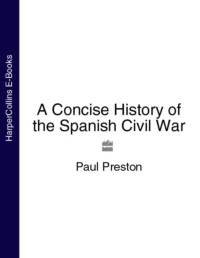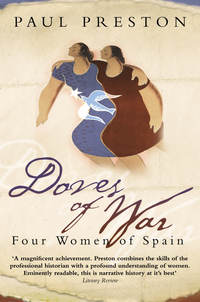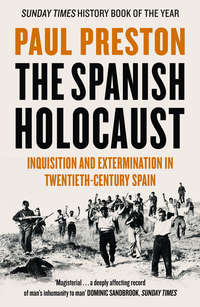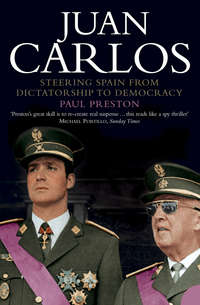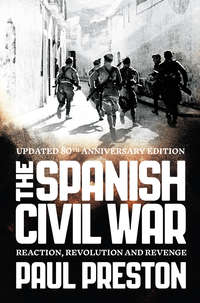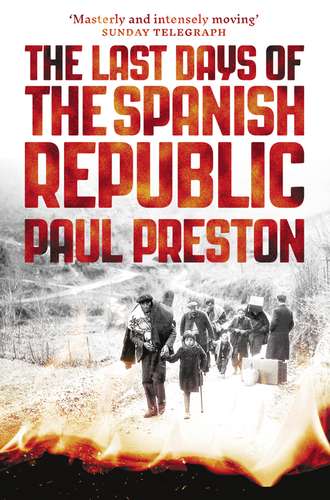
Полная версия
The Last Days of the Spanish Republic
On 7 October the Army of Africa resumed its march on a Madrid inundated with refugees and beset by major supply problems. In an effort to rally the population, on 4 November, Largo Caballero added two anarcho-syndicalist ministers to his cabinet in the hope of widening popular support for the beleaguered Republic. Franco’s delay permitted the morale of the defenders of Madrid to be boosted by the arrival in early November of aircraft and tanks from the Soviet Union together with the columns of volunteers known as the International Brigades. The siege of Madrid saw heroic efforts by the entire population. On 6 November, expecting the capital to fall quickly, the government fled to Valencia. The city was left in the hands of General José Miaja. Backed by the Communist-dominated Junta de Defensa, the unkempt Miaja rallied the population while his brilliant chief of staff, Colonel Vicente Rojo, organized the city’s forces. The first units of the International Brigades reached Madrid on 8 November, and consisted of German and Italian anti-fascists, plus some British, French and Polish left-wingers. Sprinkled among the Spanish defenders at the rate of one to four, the brigadiers both boosted their morale and trained them in the use of machine guns, in the conservation of ammunition and in the methods of using cover. They successfully resisted Franco’s African columns and, by late November, he had to acknowledge his failure. The besieged capital would hold out for another two and a half years until the fateful sequence of events triggered by Colonel Casado.
The arrival of Russian equipment and international volunteers in the autumn helped save Madrid. However, their presence was also to be used by Franco’s sympathizers to justify the intervention of Hitler and Mussolini and inhibit the Western powers. The motivation of both Germany and Italy was principally to undermine the Anglo-French hegemony in international relations, yet both dictators received a sympathetic ear in London when they claimed to be in Spain to combat bolshevism. Besieged, the Republic also had complex internal problems unknown in Franco’s brutally militarized zone. The collapse of the bourgeois state in the first days of the war had seen the rapid emergence of revolutionary organs of parallel power – the committees and militias linked to the left-wing unions and parties. A massive popular collectivization of agriculture and industry took place. Exhilarating to participants and foreign observers like George Orwell, the great collectivist experiments of the autumn of 1936 were an obstacle to the creation of a war machine. Opposing beliefs about whether to give priority to war or revolution would lie at the heart of the internal conflict that raged within the Republican zone until mid-1937. The Republican President, Manuel Azaña, and moderate Socialist leaders like the Minister of the Navy and Air Force, Indalecio Prieto, and the Minister of Finance, Juan Negrín, were convinced that a conventional state apparatus, with central control of the economy and the institutional instruments of mass mobilization, was essential for an efficacious war effort. The Communists and the Soviet advisers agreed – it made sense and they hoped that halting the revolutionary activities of Trotskyists and anarchists would reassure the bourgeois democracies being courted by the Soviet Union.
Preoccupied by internal dissensions, and still without a conventional army, the Republic was unable to capitalize on its victory at Madrid. Franco’s immediate response was a series of attempts to encircle the capital. At the battles of Boadilla (December 1936), Jarama (February 1937) and Guadalajara (March 1937), his forces were beaten back, but at enormous cost to the Republic. Concentration on the defence of Madrid meant the neglect of other fronts. Málaga in the south fell to newly arrived Italian troops at the beginning of February. The war in central Spain saw no easy victories. At Jarama, the rebel front advanced a few kilometres, but made no strategic gain. The Republicans lost 25,000 men, including some of the best British and American members of the Brigades, and the rebels about 20,000. In March, the rebels made further efforts to encircle Madrid by attacking near Guadalajara, 60 kilometres north-east of Madrid. An army of 50,000, the best-equipped and most heavily armed force yet seen in the war, broke through, but was defeated by a Republican counter-attack. Thereafter, as the Republic organized its People’s Army (Ejército Popular de la República), the conflict turned into a more conventional war of large-scale manoeuvre.
Even after being defeated at the battle of Guadalajara, in which a large contingent of Italian troops was involved, the rebels still held the initiative because each reverse for Franco saw the Axis dictators increase their support. This was demonstrated during the rebel campaign in northern Spain in the spring and summer of 1937. In March, Mola led 40,000 troops in an assault on the Basque Country backed by the terror-bombing expertise of the German Condor Legion. In a rehearsal for the Blitzkrieg eventually unleashed on Poland and France, Guernica was annihilated on 26 April 1937 to shatter Basque morale and undermine the defence of the capital, Bilbao, which fell on 19 June. Thereafter, the rebel army, amply supplied with Italian troops and equipment, was able to capture Santander on 26 August. Asturias was quickly overrun during September and October. Northern industry was now at the service of the rebels. This gave them a decisive advantage to add to their numerical superiority in terms of men, tanks and aeroplanes.
The defeats suffered by the Republic during early 1937 would lead eventually on 17 May to the establishment under the premiership of Juan Negrín of a strong government from which the anarcho-syndicalists were dropped. Already, as Minister of Finance and with the help of his under-secretary Francisco Méndez Aspe, Negrín had systematized the Republic’s exports of raw materials and its imports of weaponry and food. He had reorganized the Corps of Carabineros (border guards) to put a stop to smuggling and illegal exports. His contribution to the war effort cannot be exaggerated.22 Now, as Prime Minister, Negrín put his faith in the brilliant strategist Colonel Vicente Rojo, who tried to halt the rebels’ inexorable process by a series of diversionary offensives. At the village of Brunete, west of Madrid, on 6 July, 50,000 troops smashed through enemy lines, but the rebels had enough reinforcements to plug the gap. For ten days, in one of the bloodiest encounters of the war, the Republicans were pounded by air and artillery attacks. At enormous cost, the Republic slightly delayed the eventual collapse of the north. Brunete was razed to the ground. Then, in August, Rojo launched a bold pincer movement against Zaragoza. At the small town of Belchite in mid-September, the offensive ground to a halt. As at Brunete, the Republicans gained an initial advantage, but lacked sufficient force for the killer blow. In December, Rojo launched a further pre-emptive attack against Teruel, in the hope of diverting Franco’s latest assault on Madrid. The plan worked. In the most intense cold, the Republicans captured Teruel on 8 January 1938 – the only time that they managed to capture a provincial capital that had been in rebel hands. However, the triumph was short-lived. The Republican forces were dislodged after six weeks of heavy battering by artillery and bombers. After another costly defence of a small advance, the Republicans had to retreat on 21 February, when Teruel was on the point of being encircled. The casualties on both sides had been alarmingly high.
The Republicans were exhausted, short of guns and ammunition and demoralized after the defeat at Teruel. Franco now seized the initiative with a well-resourced offensive through Aragon and Castellon towards the sea. A total of 100,000 troops, 200 tanks and nearly 1,000 German and Italian aircraft began their advance on 7 March 1938. By early April, the rebels had reached Lérida and then moved down the Ebro valley, cutting off Catalonia from the rest of the Republic. By 15 April, they had reached the Mediterranean. In consequence, there was no shortage of senior figures on the Republican side who considered that the war could not now be won. Among them could be found both the chief of staff, Colonel Rojo, the head of the air force, Colonel Ignacio Hidalgo de Cisneros, and that eternal pessimist Indalecio Prieto. Negrín, however, refused to acknowledge the possibility because he was aware of the dangers of defeatism.23 He remained confident in continued Russian logistical support. However, Russian deliveries were few after June 1938. Already, by the late summer of 1937, attacks on neutral shipping by rebel warships and Italian submarines had closed the Mediterranean as a supply route for the Republic. Russian supplies now came from Murmansk or the Baltic ports and were unloaded in Le Havre or Cherbourg and then transported to the French–Spanish border.24 To get them across France, Negrín had to spend valuable foreign currency bribing local officials. As the the Minister of Agriculture, the senior Communist Vicente Uribe, later commented: ‘To get the necessary mechanisms working in France, it was necessary to grease them copiously, according to Negrín, with the funds of the Republic.’25 In June 1938, the frontier was closed by the French Prime Minister Edouard Daladier and remained closed until late January 1939. The situation was most desperate in Catalonia, where the difficulties of supply of weaponry and food grew ever more acute. Daladier opened the frontier reluctantly only after Negrín told the recently appointed French Ambassador Jules Henry that Republican defeat in Catalonia and the arrival of German and Italian forces at the Pyrenees would constitute a threat to the security of France.26
That being the case, Franco could have been tempted to adopt a more attacking strategy. However, he was more interested in the total destruction of the Republican forces than in a quick victory, and he ignored the opportunity to turn against a poorly defended Barcelona. Instead, in July 1938, he launched a major attack on Valencia. The Republicans’ determination in defence ensured that progress was slow and exhausting but, by 23 July, Valencia was under direct threat, with the rebels less than 40 kilometres away. In response, Vicente Rojo now launched another spectacular diversion in the form of a daring push across the River Ebro to restore contact between Catalonia and the central zone, separated since the Francoists had reached the Mediterranean in April. In the most hard-fought battle of the entire war, the Republican army of 80,000 men crossed the river and broke through the rebel lines, although at great cost to the International Brigades.
For some time, Negrín had pinned his hopes on an escalation of European tension that would alert the Western democracies to the dangers facing them from the Axis. The outbreak of a general European war would, he hoped, see the Republic aligned with France, Britain and Russia against Germany and Italy. Any such hopes were dashed when the Republic was virtually sentenced to death by the British reaction to the Czechoslovakian crisis. British foreign policy had long been orientated in favour of a Francoist victory. Rather than risk war with Hitler, Chamberlain effectively surrendered Czechoslovakia to the Nazis when he signed the Munich Agreement of 29 September 1938. It was a devastating blow to the Spanish Republic which, since July, had been engaged in its last great battle, at the Ebro. Even before the betrayal by the Western powers, Stalin had ordered the withdrawal of the International Brigades from Spain.27
The more immediate military objective for which the huge Army of the Ebro was created had been to divert the rebel attack on Valencia. Given the Republic’s lack of armaments, it was an immensely risky venture. By 1 August, the Republicans had reached Gandesa 40 kilometres from their starting point, but there they were bogged down when Franco ordered massive reinforcements, including the Condor Legion, to be rushed in to check the advance. With inadequate artillery and air cover, the Republicans were subjected to three months of fierce artillery bombardment and sweltering heat.28 Despite its strategic irrelevance, Franco was determined to recover the lost ground irrespective of the cost and relished the opportunity to catch the Republicans in a trap, encircle and destroy them. He could simply have contained the Republican advance and driven forward against a near-helpless Barcelona. Instead, he preferred, irrespective of the human cost, to turn Gandesa into the graveyard of the Republican army. With nearly 900,000 men now under arms, he could afford to be careless of their lives. At stake in this desperate and ultimately meaningless battle was the international credibility of the Republic. Munich had undermined the already dwindling faith in the possibility of victory among both the civilian population and the officer corps. Overwhelming logistical superiority in terms of air cover, artillery and troop numbers would see Franco score a decisive victory. In a sense, the Ebro operation, initially a tactical success, was a strategic disaster for the Republic since it used up vast quantities of equipment and left the way open for the rebel conquest of Catalonia.29
Ten days before the signing of the Munich Agreement, Vicente Rojo had drawn up a detailed report on the Republic’s military situation in the context of the Czechoslovak crisis. It was his hope that the democracies would resist Hitler’s demands and provoke a general war in which the Spanish Republic would be allied with Britain and France.30 Neverthless, he also analysed the likely consequences should the democracies give in to Hitler. Rojo’s conclusion was that such a capitulation would give Italy and Germany an even freer hand to help Franco than hitherto: ‘our war would enter, in such a case, a period of acute crisis because of the greater difficulties that we would have to overcome in order to sustain the struggle against an ever more powerful enemy’. Nevertheless, Rojo was still optimistic that ‘a favourable resolution of our conflict’ could be achieved. For this to happen, supplies of food and war matériel would have to be secured and the army’s morale kept high and its organization improved. These two conditions he described as ‘doable. They are problems for the Government.’ To this end, he called for an effort to obtain greater foreign help and for a centrally controlled war effort such as that enjoyed by Franco – more efficient rationing, measures to be taken against those who evaded conscription, a single command for all the armed forces, central control of transport facilities and of industry, and an end to the proliferation of political parties and of competing newspapers.31
What Rojo was suggesting was as necessary as it was impossible. To achieve the fully centralized war effort to which Negrín and the Communist Party had aspired since the beginning of the conflict had already provoked opposition from anarchists, Trotskyists and sections of the Socialist Party. To go further, as Rojo now suggested, would generate even greater resentment. In any case, given the scale of the myriad problems faced by Negrín, the enormous reorganization required was simply out of the question. What Negrín did manage to do, along with his secret peace initiatives, was to intensify his efforts to secure military supplies from Russia. He successfully negotiated the supply of aircraft, tanks, artillery and machine guns. While what was agreed was less than he had hoped for, these armaments could have made a huge difference if, after their arrival in France in mid-January, they had been transported to the Catalan border. However, the continuing obstacles placed in the way by the French government ensured that they did not arrive in time.32 Another aspect of Rojo’s report would also have disappointing results. He added an appendix on military plans in which he talked of the relief that could be given to the Republican forces on the Ebro by the launching of offensives in the centre-south zone.33 The four armies that made up what was called the Group of Armies of the Centre (Grupo de Ejércitos Republicanos del Centro) – Extremadura, Andalusia, the Levante and the Centre – were under the overall command of General Miaja, with General Manuel Matallana Gómez as his chief of staff. The Army of the Centre was commanded by Colonel Casado. Since all three were reluctant to continue the fight, Rojo’s orders to this effect were never properly implemented.
The decisive Nationalist counter-offensive on the Ebro was launched on 30 October 1938. Concentrated air and artillery attacks on selected areas followed by infantry attacks gradually smashed the Republican forces.34 By mid-November, at horrendous cost in casualties, the Francoists had pushed the Republicans out of the territory captured in July. The remnants of the Republican army abandoned the right bank of the Ebro at Flix late at night on 15 November. As they retreated back across the river, they left behind them many dead and much precious matériel. It had taken Franco four months to recover the territory gained by the Republic in one week in July. As we have seen, he had in July rejected the more adventurous strategy of holding the Republicans near Gandesa and pushing on to Barcelona from Lérida. By so doing, Franco demonstrated his preference for attrition and for the physical annihilation of the Republican army. He thereby ensured that there would be no armistice, no negotiation of peace conditions.
It was Munich that turned the battle into a resounding defeat, especially for the Communist Party which had invested energy, resources and prestige in the Ebro initiative.35 Before, during and after the battle, this last throw of the dice contributed massively to civilian and military demoralization. After the defeat at Teruel in February and during the great Francoist advance through Aragon to the coast, the Republic had already suffered massive losses. In order to create the Army of the Ebro, the government had been obliged to call up a further nine years’ worth of conscripts (the reemplazos of 1923 to 1929, and of 1940 and 1941). The need to train, and rely on, both older and younger men had a negative impact on the Catalan economy and society at large. Labour was in short supply and families were outraged that, during the battle of the Ebro, many Republican soldiers were seventeen-year-old adolescents. During the battle itself, army requisitioning, effectively the troops scavenging off the land, exacerbated the growing discontent. Further tension was caused by the Republican military intelligence service (Servicio de Inteligencia Militar, or SIM) which was pursuing those who had evaded conscription and those who had deserted.36 Approximately 13,250 Spaniards and foreigners were killed, 6,100 (46 per cent) of them Francoists and 7,150 (54 per cent) Republicans. In roughly similar proportions, about 110,000 suffered wounds or mutilation. The richly fertile Terra Alta became a vast cemetery – tens of thousands of men were buried quickly, many were left where they lay and others drowned in the river. To the dismay of the local peasantry, and to the detriment of the Republican war effort, the fighting ruined the harvest of wheat and barley in July, of almonds in August, of grapes in September and of olives in November.
Negrín was fully aware of the significance of Munich. He knew that Republican victory was impossible. In late September 1938, the deputy secretary of the PSOE executive, Juan-Simeón Vidarte, told him that the committee’s members remained convinced that the unconditional surrender demanded by Franco was out of the question. Commenting that no one forgot what had happened in Andalusia, Extremadura, the Basque Country and Asturias, he remarked: ‘We can’t hand over half of Spain and an army of a million men so that they can exterminate them as they like.’ Negrín replied with resigned realism: ‘Guarantees for an honourable peace is all that I want.’37 To this effect, he consulted the Republic’s legal adviser Felipe Sánchez Román, who drafted the minimal conditions which Negrín accepted as the basis for negotiations with Franco, including a promise not to take reprisals against the supporters of the Republican government and a guarantee to maintain public order.38
Another close friend of Negrín, the cardiologist Dr Rafael Méndez Martínez, at the time Director General of the border guards, the Carabineros, wrote later of how the spirit of victory had been tranformed into the spirit of resistance that would last until such time as it was possible to achieve ‘the second of his aims, a satisfactory peace’. In this regard, he believed that only an effective and well-ordered resistance that prolonged the war might persuade the democracies to help negotiate such a settlement. ‘Once Negrín had accepted that victory was impossible, the nub of his policy was resistance to the end and the mobilization of international support to achieve a peace settlement that would prevent the extermination of thousands and thousands of Republicans.’ His peace initiatives included a secret meeting with the German Ambassador in Paris.39
Over the next two months, their success at the Ebro would see Franco’s forces sweep through Catalonia. Confident that, after Munich, the Republic would not find salvation in a European war, Franco gathered over 30,000 fresh troops. He granted substantial mining concessions to the Third Reich in return for sizeable deliveries of German equipment.40 With the French frontier closed and help from the Soviet Union reduced to a trickle, Franco had every possible advantage for his final push. Months of Italian bombing raids had taken their toll on morale. An immense army was gathered along a line surrounding Catalonia from the Mediterranean in the east to the Ebro in the west and to the Pyrenees to the north. Originally planned for 10 December, the offensive was postponed until the 15th. Further delays were caused by a period of torrential rain and it was eventually launched on 23 December.41 The scale of war-weariness, resentment of the conflict’s human and economic costs and defeatism in the wake of Munich made a successful defence seem the remotest possibility. Nevertheless, despite the overwhelming superiority of the attacking forces in terms of air cover, artillery and sheer numbers, the Republican retreat never turned into a rout. Franco could rotate his troops every forty-eight hours while the Republicans had had no leave for seven weeks.
The forces of Enrique Líster managed to hold up the Nationalist advance for nearly two weeks at Borjas Blancas on the road from Lérida to Tarragona. Nevertheless, the advance was inexorable. On New Year’s Eve, a ferocious Italian bombing raid on Barcelona brought to the city what Negrín, in a broadcast to the United States, called ‘sorrow and mourning’. His Minister of Foreign Affairs, Julio Álvarez del Vayo, commented: ‘Perhaps this is “Happy New Year” in the Italian language.’ Herbert Matthews, who had helped Negrín polish his English for the broadcast, wrote later: ‘I had never seen him so moved.’ On 4 January 1939, the Francoists broke through at Borjas Blancas and the end was nigh for Catalonia. Without adequate armaments and with the troops drained after their superhuman efforts, the road was open to Tarragona and then on to Barcelona. The bespectacled Lieutenant Colonel Manuel Tagüeña, a tall, thin mathematician who had risen through the ranks of the militias to command an army corps, mounted a determined defence but had only a fraction of the necessary weaponry.42
In the wake of the Munich Agreement and the consequent conviction in Moscow that Russia had been betrayed by the democracies, a concern for security saw Stalin start to make tentative overtures to Nazi Germany. Engaged in a war with Japan in China, with serious preocupations in Eastern Europe, and with obstacles in the way of transport to Spain, Russia had to cut back on aid in the last six months of the Civil War just as Germany and Italy significantly increased their assistance to Franco. The consequence was, in the words of Herbert Matthews, that:
the last year of fighting was a miracle of dogged, hopeless courage, made possible solely by the tenacity and indomitable spirit of Negrín. However, this astonishing display of leadership was the most bitterly criticized feature among Spaniards of Dr Negrín’s career. The fight was hopeless, his critics said, and all that ‘unnecessary’ destruction, all those extra lives lost, all the intensified hatred of Spaniard for Spaniard, could have been avoided. It is certain, on the other hand, that the Loyalists could have held out longer had it not been for treachery, and that World War II could have saved Republican Spain … Don Juan’s aims were consistent, patriotic and honorable. He stood for a fight to the finish, first to save the Second Republic and – when that became impossible – to get the best terms for those who had remained loyal. In the process, he had to rely heavily on Stalinist Russia and then almost exclusively on the Spanish Communists.43


